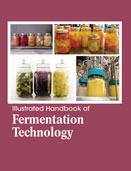Handbooks

Fermentation is the process involving the biochemical activity of organisms, during their growth, development, reproduction, even senescence and death. Fermentation technology is the use of organisms to produce food, pharmaceuticals and alcoholic beverages on a large scale industrial basis. The basic principle involved in the industrial fermentation technology is that organisms are grown under suitable conditions, by providing raw materials meeting all the necessary requirements such as carbon, nitrogen, salts, trace elements and vitamins. This illustrated work emphasizes the application of biological and engineering principles to problems involving microbial, mammalian, and biological/biochemical systems. The aim of the book is to review fundamentals and provide an up-to-date account of current knowledge in biological and biochemical technology.
Fermentation technology is the oldest of all biotechnological processes. Fermentation is a process of chemical change caused by organisms or their products, usually producing effervescence and heat. Microbiologists consider fermentation as ?any process for the production of a product by means of mass culture of micro-organisms?. In its broadest sense, fermentation refers to any process by which large organic molecules are broken down to simpler molecules as the result of the action of microorganisms. The most familiar type of fermentation is the process by which sugars and starches are converted to alcohol by enzymes in yeasts. To distinguish this reaction from other kinds of fermentation, the process is sometimes known as alcoholic or ethanolic fermentation.
Illustrated Handbook of Fermentation Technology provides principles and practices of Fermentation Technology.
Fermentation has been used for thousands of years all over the world, from areas like modern day Israel, Iran and Mexico to Sudan, Egypt, Georgia & ancient Babylon. The process was used to produce wine, beer, cultured milk (kefir) and leavened/yeasted bread. It wasn?t discovered until the mid 1800?s that bacteria and fungi were the agents responsible for the process. The alcoholic beverages that can be produced by fermentation vary widely, depending primarily on two factors, the plant that is fermented and the enzymes used for fermentation. Human societies use, of course, the materials that are available to them. Thus, various peoples have used grapes, berries, corn, rice, wheat, honey, potatoes, barley, hops, cactus juice, cassava roots, and other plant materials for fermentation. The products of such reactions are various forms of beer, wine, or distilled liquors, which may be given specific names depending on the source from which they come. Early in human history, people used naturally occurring yeasts for fermentation. The products of such reactions depended on whatever enzymes might occur in those ?wild? yeasts. Today, wine-makers are able to select from a variety of especially cultured yeasts that control the precise direction that fermentation will take. Fermentation has a number of commercial applications beyond those described thus far. Many occur in the food preparation and processing industry. A variety of bacteria are used in the production of olives, cucumber pickles, and sauerkraut from raw olives, cucumbers, and cabbage, respectively. One of the most successful commercial applications of fermentation has been the production of ethyl alcohol for use in gasohol. Gasohol is a mixture of about 90 percent gasoline and 10 percent alcohol. Another application of the fermentation process is in the treatment of wastewater. In the activated sludge process, aerobic bacteria (bacteria that can live without oxygen) are used to ferment organic material in wastewater. Solid wastes are converted to carbon dioxide, water, and mineral salts. The Illustrated